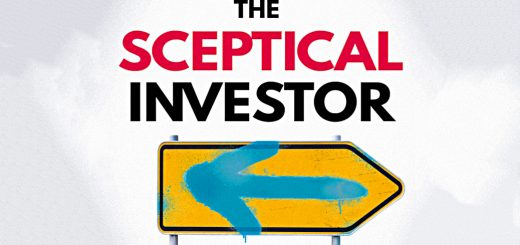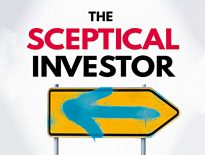The Sceptical Investor 3 – Media, Incentives and Humility

Today’s post is our third visit to a popular UK investing book from last year – The Sceptical Investor by John Stepek.
Media
John begins chapter 7 with a story about a newspaper headline in January 2009 – “The worst recession”.
What struck me was the picture they’d chosen to illustrate it. It was an image of St Paul’s Cathedral during the Blitz. It seemed to be saying: `This is as bad as the Blitz. This is an existential crisis. Take cover now.’
And that, of course, was a gross exaggeration. It wasn’t - by any stretch of the imagination - the second world war. When people are as scared as they can get, the only way is up.
In fact, the FTSE-100 bottom was around a month away. But three months later, the market was higher again.
So if you’d started drip-feeding money in on the day that you’d have been back to even within three months, and you’d have remained above water for the rest of the subsequent bull market.
This is a striking example of the “magazine cover indicator”.
By the time an investment story has become so popular that it can hit the front page of a major media publication, its days as a profitable idea must be numbered. Everyone who is interested in the story has almost certainly already bought into it.
Or as Jonathan Compton says:
If it’s in the press, it’s in the price.
Paul Macrae Montgomery came up with the idea in the early 1980s by looking through old Time magazine covers.
- He found that bullish covers were only good for a month.
Over the next 11 months, they were a contrarian indicator.
- The same was true in reverse for bearish covers.
- Economist, BusinessWeek and Newsweek covers have been used in the same way.
It works with individual companies, as well as asset classes and indices.
The nature of the coverage reflected the prior performance of the stocks, rather than the future prospects.
And it works with celebrity CEOs, too.
Why?
Journalists do not `manufacture’ the news. They are chasing audience share. People want to read news that confirms their own world view and that addresses their concerns.
Which means that journalists write stories in tune with the zeitgeist, rather than rock the boat with warnings that the future will be different.
Reading the headlines is not about looking at the pieces on the board or analysing the fundamentals of the market. It’s about getting an understanding of what the other players’ mental models look like right now, and how you can take advantage.
The media tends to focus on the outliers, and outliers tend to regress to the mean.
John recommends physical news (papers and magazines) where possible since these are aimed at a general audience.
- The stuff you see online is tailored for you.
Mainstream newspapers are not in the business of selling genuinely contrarian ideas. When someone chooses to read a newspaper or political magazine regularly, they generally want to see their own biases reflected back at them. They don’t want to be overly challenged.
Incentives
In chapter 8, John looks at how the 2008 crisis was caused by rational behaviour in the face of incentives.
The Federal Reserve, under Alan Greenspan, had made it very clear that when hard times loomed for markets, the US central bank would cut interest rates.
Rising asset prices and falling interest rates made the quest for `yield’ an increasingly desperate affair.
This explains how high yielding mortgage-backed securities became popular in the first place.
Credit rating agencies used flawed statistical models to prove that they could layer low-risk and high-risk mortgages together, such that holders earned a higher-than-average yield while taking lower-than-average risk.
The credit rating agencies however, were paid to rate these bonds by the banks who had created the bonds in the first place.
The banks needed all the mortgages they could find so they were paying mortgage brokers to generate more business. The broker writing the loans didn’t care if the homeowner repaid the debt, because he was selling the mortgage to the banker.
The banker didn’t care, because she sold it to the institutional manager. The institutional manager didn’t care, because the bank had paid the credit rating agency to rubber stamp the whole thing.
Everyone involved got paid upfront, while the risk was passed right on down the chain to some other mug.
Even the individuals who did the most to uncover the whole debacle only did so because they could make a fortune (and many did).
It’s important to remember that incentives are not purely external or financial. We have a desire to be perceived to be consistent in our behaviour, and to attain social approval.
But this internal incentive to behave in a socially acceptable way can be entirely short-circuited by external incentives. Payment can effectively license behaviour that would otherwise be socially unacceptable.
John mentions blood money in feudal societies, where payments replace vengeance.
The very existence of a system creates moral hazard by allowing individuals to dispense with personal responsibility and just follow the rules.
The agency problem
Perhaps the biggest and most obvious incentive issue in investment is the agency problem. The people who run the company (the management team) are not the ones who own the company (the shareholders).
A manager has every incentive to do the minimum amount of work necessary to claim their salary. They may also be less inclined to take tough decisions on managing resources efficiently.
The way people tried to get around this was through stock options for managers. But:
The rewards accruing to executives have risen far more rapidly than the share prices of their companies in general. Moreover, between 2006 and 2015, the more a company paid its CEO, the less well it did.
By imposing an external incentive scheme, you immediately short-circuit the CEO’s intrinsic motivation, common sense and sense of duty or pride in simply doing a good job, in favour of focusing tightly on maximising whatever it takes to get the money.
Companies have also tended to settle on earnings per share (EPS) as an easy way to measure CEO performance. The problem is that there are plenty of ways to boost EPS, many of which are destructive in the long run.
The four obvious ones are cutting costs (including investment and R&D), debt-funded acquisitions, aggressive accounting and share buybacks.
The other problem with high executive pay is:
How motivated can any individual be when they have the potential to earn life-changing sums of money in just a few years at the top? Once you know that you could quit tomorrow then you don’t have to worry about what happens in five years’ time.
Why don’t shareholders do anything about this? Mainly because many of them are `agents’ too.
Stocks are no longer owned by individuals, but by institutions.
- As as we saw in an earlier article, fund managers have short-term incentives and are highly paid themselves.
All you can do is avoid the companies that are the worst offenders.
- High pay, the concentration of power, incentive payments with low bars and acquisitiveness are things to look out for.
John also says that consistent outperformance is a warning sign of earnings manipulation.
- And you should avoid IPOs, particularly from private equity firms.
Good things to look for include skin in the game (as found in family firms, and quite a few investment trusts).
The Templeton dot com trade
In the first half of 2000, Templeton picked out 84 stocks, and invested an average of $2.2m in each, betting that their prices would fall. Within a year, he had made more than $100m on the trade. More than half of the stocks that he bet on fell in price by 95% or more.
He looked for stocks that were selling for three times the price that they first went public at. He looked at the incentive packages of the founders of these companies.
And the positions that Templeton had taken were designed to kick in 11 days before `lockup expirations’. That’s the point at which the insiders were first allowed to sell their shares and cash in.
The clever part was in understanding the prevailing incentive structure of the day.
Humility
John starts chapter 9 with the story of Hugh Hendry, a hedge fund manager who got the 2008 crisis right but stayed doomy for too long.
I found myself unable to forgive the Federal Reserve and the other central banks for … bailing out Wall Street from the excess of 2008. I just couldn’t get over it.
In 2017 he shut down his fund.
By the time it was closed down, assets under management had dwindled from a high of well over $1bn in 2013, to just above $30m.
This raises an issue applicable to any would-be contrarian investor:
If you are willing to go against the crowd consistently, then you are already primed to believe that you know better than the rest. If you then make out like a bandit while everyone else is whimpering, this stubbornness and sense of superior understanding will only be reinforced.
The danger then is that you fall into the trap of thinking: `I’m right, and everyone else is an idiot.’ You become convinced that your own world view - the one that made you all that money - is still correct.
You fail to recognise that your once-contrarian outlook is no longer a bold, minority take, but in fact the dominant paradigm.
John has fives signs that warn of potential hubris:
- You dismiss arguments that you don’t want to hear.
- You are never bullish (even though bull markets are more common).
- You don’t mind being wrong because you “disapprove” of the market.
- You are blaming everyone else.
- No one disagrees with you any more.
John tells the story of John Maynard Keynes, a successful and arrogant investor as well as a great economist.
- Keynes lost 80% of his wealth in the 1929 crash.
As a result, he switched from market timing to value investing, with great success.
- By 1935 he had turned his remaining £8K back into £500K.
- From 1933 to 1946 (when he died) he made 13% pa, without reinvesting dividends.
John has a few tips on how to be more intellectually humble:
1 – Remember that beating the market isn’t about having the highest IQ.
2 – Understand the limits of your “circle of competence”.
3 – Rent opinions, don’t buy them – this is a version of “strong opinions, weakly held”
- Don’t get too attached to your view, or avoid evidence which contradicts it (confirmation bias)
4 – Get comfortable with not having an opinion.
5 – Be actively open-minded.
Foxes (people who know a little about a lot) are better at forecasting than hedgehogs (people who have a lot of knowledge within a small field). So read widely and expose yourself to as many different ways of looking at the world as possible.
6 – Seek out quality information.
7 – Get angry, but understand why.
- Get to grips with the articles that make you mad.
8 – Don’t be afraid to admit being wrong.
- Buy back in if selling proves to be a mistake.
9 – Don’t get cocky.
When an investment goes the way you thought it would, it can be a good idea to take a break. If you’re feeling euphoric, consider taking your winnings off the table. You will now feel instinctively attached to the viewpoint that has proved profitable for you.
That’s it for today.
It’s been another fun read, with plenty of insight.
- But not much of it is actionable, and what is is subjective and open to interpretation, rather than systematic.
Up next are bubbles, valuations and forecasts.
- Until next time.














